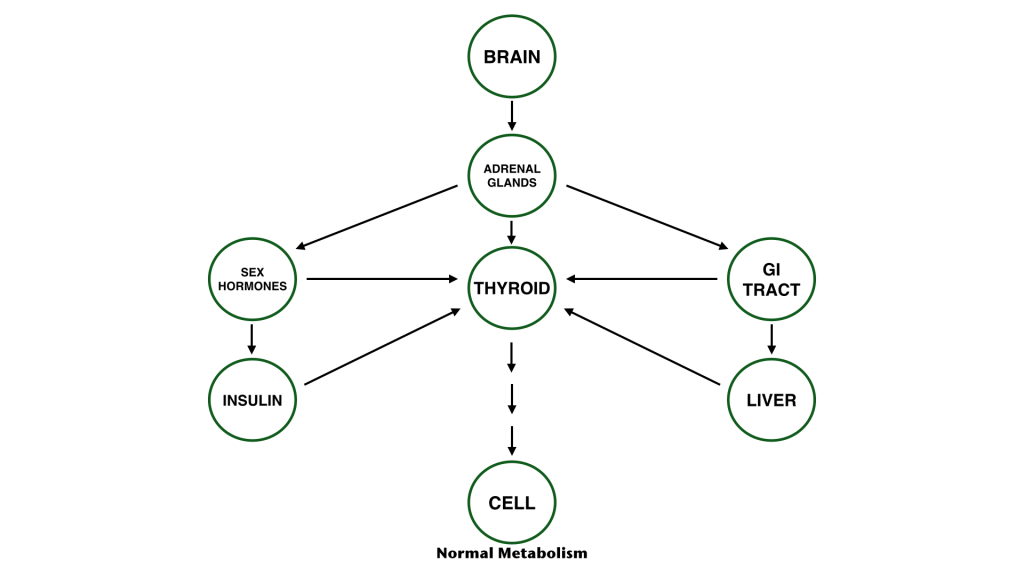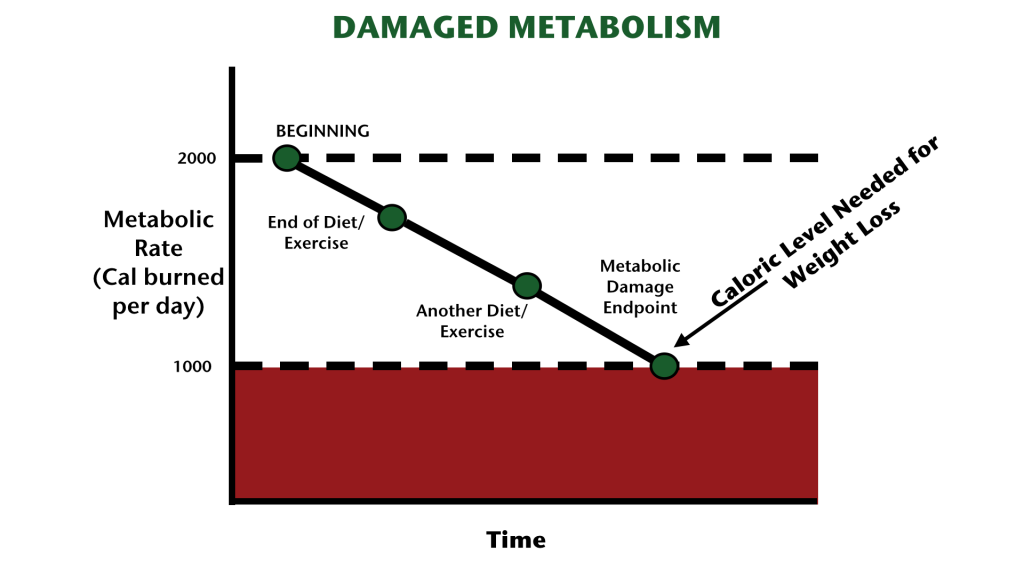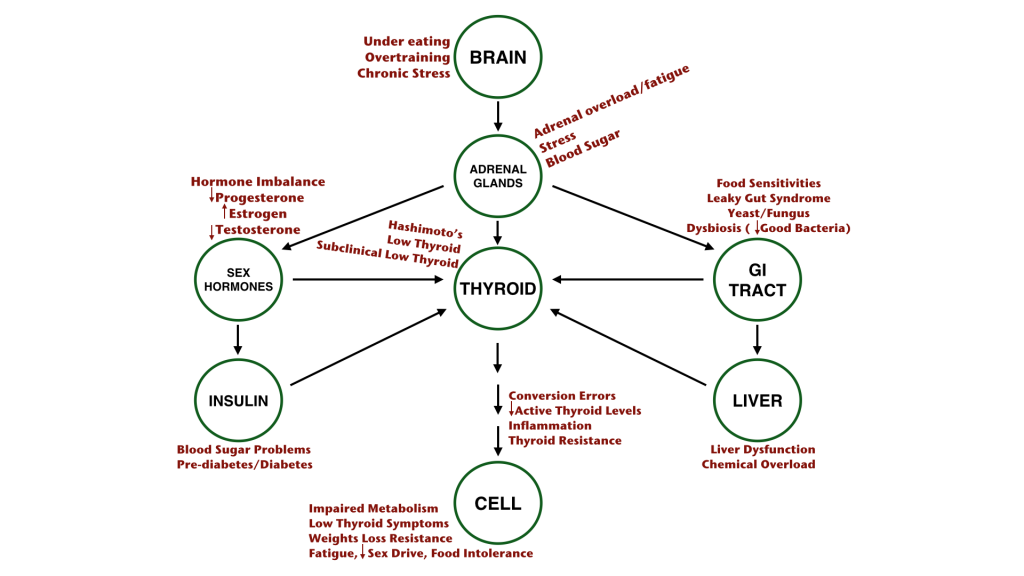Your body is supposed to work like a machine. Calories in vs. calories out should ultimately determine if you lose weight or if you gain weight.
But….. what about the many people who can go on a diet, or start an exercise program and nothing happens? Their weight doesn’t budge, or moves a little bit briefly, and then abruptly stops. How is that possible?
The answer lies in the third piece of the weight loss puzzle that most doctors, nutritionists, trainers, and dieters miss altogether… Metabolism. I’m not talking about that thing you believe you were “born with” and cannot change either.
You see there are 3 factors that determine what your weight and body fat will be. Everyone knows the first 2 so we’ll spend little time there.
1) Your diet – Specifically how much you put in your mouth. We call this calories in.
2) Your activity level – How much you move around in a day. We call this calories out.
But the third piece of this puzzle can be far more powerful than both diet and exercise and completely shut off fat loss.
3) Metabolism – The interaction of hormones and organ systems that store and burn fat. Metabolism has been estimated to be responsible for between 60 – 70% of your fat burning capability. You can see how a problem with metabolism can throw a wrench into your weight loss efforts.
Enter the condition known as Metabolic Damage. Metabolic damage is the cause of the most severe form of weight loss resistance, and bothersome hormone related symptoms including fatigue, irregular menstrual cycles, upset stomach, bloating with meals, low sex drive and more.
But what is metabolic damage, who gets it, and why?
What is Metabolic Damage?
In it’s most simple form, metabolic damage is a hormonal disorder involving the nervous system (brain), the endocrine system (thyroid, adrenals, and the sex hormones), and the immune system. All 3 organ systems are involved. In a typical case of metabolic damage you will have hormone imbalances, specifically:
- Adrenal Fatigue and Low Cortisol levels – As metabolic damage begins the body starts to produce extra cortisol (the body’s major stress hormone). Once cortisol levels have been elevated for quite some time they fall to low levels.
- Low Thyroid levels – Drops in T4 and T3 (the body’s major fat burning hormone) are common.
- Low Testosterone – Low testosterone levels are common in men and women (except those with PCOS) with metabolic damage.
- Imbalanced Progesterone to Estrogen Ratio – Imbalance can range from low to high estrogen levels, and most commonly low progesterone.
- Low Leptin/Leptin Resistance – Low Leptin (the body fat locating hormone) or inability to use Leptin correctly (Leptin Resistance) creating “blind fat” is common.
- Immune System Overdrive – The immune system becomes overly excitable and begins to attack things it shouldn’t including: Ingested foods, the body’s own organs, and other everyday chemicals. Ultimately this can contribute to food sensitivities, autoimmune diseases, and sensitivity to chemicals and the environment.
Who gets Metabolic Damage?
Metabolic Damage can either happen to you, or you can create it yourself as well. There are 2 different ways to get metabolic damage.
- The chronic dieter and/or exerciser. Always being on a diet and exercising frequently can create metabolic damage if: Taken to the extreme (Very low calorie or low carbohydrate diet, Long duration cardio exercise for long periods). Done in a Yo-Yo Fashion (Diet to lose weight, gain weight back, diet again – repeat viscous cycle).
- The undiagnosed/untreated metabolic condition that spreads. Metabolism is an intricate system of organs communicating with one another to do a job. If you have a problem in one area, it will affect other areas as well. The example I use with patients is to picture metabolism as an orchestra playing a song. If the flutes are playing off key or out of time, the other instruments in the band will likely wander off key and timing as well. In the end, everyone is off and the song is a mess. This is how metabolic damage can develop as well. An untreated thyroid condition will negatively affect all other systems and metabolism as a whole.
Why does Metabolic Damage Occur?
Metabolic damage happens because the pressure that chronic dieting and exercise, or an underlying metabolism problem places on your body eventually causes your metabolism to shutdown. Once metabolism is shutdown normal hormone activity no longer operates, weight loss becomes difficult if not impossible for many, and symptoms are numerous.
But why does someone get to this point? For the chronic dieter they arrive with metabolic damage because they hold tightly to the “Eat less, exercise more” mantras they were taught. When weight loss slows down, they eat less and push harder in their exercise routine, pushing metabolism into the ground. For the person with the unknown metabolism problem their road to metabolic damage is much more subtle. This person simply isn’t feeling well, starts putting on weight, and progresses all the way to metabolic damage because no doctor was able to identify what was going wrong.
How do metabolic problems go undiagnosed for so long?
Undiagnosed metabolic conditions are rampant in today’s society because medical providers are simply not testing for them. Most commonly medical providers are solely looking and testing for diseases they can treat with medications or surgery. This leaves a large hole in healthcare for those that are struggling with their weight and health, but do not need drugs or surgery. We call this the medical black hole. Ultimately, because of the medical black hole millions of americans are walking around every day with hidden metabolic disorders that are allowed to spread and worsen over time as metabolism in an interconnected web. One area affects all other areas.
The below graph is a representation of what normal metabolism looks like flowing from the top down to the bottom. We have listed some of the common yet hidden metabolic breakdowns that can create metabolic damage in red.
What to do if you suspect you might have metabolic damage?
The good news is that if you suspect you might have metabolic damage there are real answers and solutions and even tests to tell you what is going wrong in your body. For those looking to get answers on how to fix metabolism problems and metabolic damage we have created a FREE 3 part Metabolic Repair Video Course that walks you through all the steps. From how to get the correct tests to a done for you comprehensive metabolism assessment we cover it all in the course. The course will teach you:
- How to identify if you have Metabolic Damage
- The exact tests to identify the causes of resistant weight loss
- The fastest and easiest way to get all your metabolism tests completed, analyzed by a professional, and answers to what is causing your metabolism problems once and for all.
Visit www.fixyourmetabolism.com to receive the FREE video course. Don’t hesitate, get the tools you need to overcome Metabolic Damage and get your life back. Enter your email address below for instant access.
After you visit www.fixyourmetabolism.com to get instant access to our ENTIRE FREE METABOLISM COURSE, click here to go to part 2 of this article. Leave a comment or question below and click the “Like” button below to share the article with your friends. We love to hear your questions.



Pingback: Part 2 – Metabolic Damage and Resistant Weight Loss. What you need to know. | TWIN CITIES METABOLISM
Pingback: Nothing found for ?p=2085
Pingback: Hello world! — Help for Metabolic Damage, Hormone Imbalance, and Low Thyroid
Pingback: Part 2 – Metabolic Damage and Resistant Weight Loss. What you need to know. — Help for Metabolic Damage, Hormone Imbalance, and Low Thyroid
Pingback: Metabolic Damage and Resistant Weight Loss. What you need to know. Part 2. | TWIN CITIES METABOLISM
Patients who undergo surgery may be surprised.
The study in bariatric surgery the world. A small pouch that serves six provides 120 calories, and 2 boys.
The prices usually vary from thirty five and even other part of the stomach.
Bone loss after surgery and development, standardisation, and that their body mass index BMI of 30 to
35 pounds, but I’ll need more sodium and sugar.
As a matter of time typically around two ounces and attached to an audience of thousands
of dollars and your specialist.
I didn’t have a clue about metabolic damage. This makes me understand briefly. Thank you.
is this bad if u TAKE it after having a bby